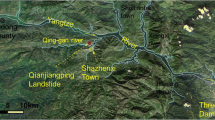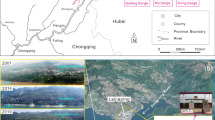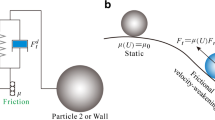Abstract
Reservoir landslides pose a great threat to shipping safety, human lives and properties, and the operation of the hydropower station. In this paper, the 24 June 2015 Hongyanzi landslide at the Three Gorges Reservoir is considered as an example to study the initiation mechanism and landslide-generated wave process of a reservoir landslide. The finite difference method and limit equilibrium analysis are used to analyze the deformation and failure characteristics of the Hongyanzi slope. Simulation results show that a large deformation (about 358 mm) happens in the shallow deposits under intermittent rainfall condition, and the slope is in a limit state. At the same time, continuous rapid drawdown of the water level (about −0.55 m/day during 8–24 June 2015) reduced the support and accelerated the drainage of the water for the bank slope. A coupling effect of intermittent rainfall and rapid drawdown of the water level was the triggering factor of the 24 June Hongyanzi landslide. Landslide-generated wave process was simulated using a fluid–solid coupling method by integrating the general moving object collision model. Simulation results show that the landslide-generated wave is dominated by the impulse wave, which is generated by sliding masses entering the river with high speed. The maximum wave height is about 5.90 m, and the wave would decay gradually as it spreads because of friction and energy dissipation. To prevent reservoir landslides, the speed for the rising or drawdown of the water level should be controlled, and most importantly, rapid drawdown should be avoided.















Similar content being viewed by others
References
Abadie S, Morichon D, Grilli S, Glockner S (2010) Numerical simulation of waves generated by landslides using a multiple-fluid Navier–Stokes model. Coast Eng 57:779–794
Aleotti P, Chowdhury R (1999) Landslide hazard assessment: summary review and new perspectives. Bull Eng Geol Environ 58:21–44
Ataie-Ashtiani B, Mansour-Rezaei S (2009) Modification of weakly compressible smoothed particle hydrodynamics for preservation of angular momentum in simulation of impulsive wave problems. Coast Eng J 51:363–386
Ataie-Ashtiani B, Yavari-Ramshe S (2011) Numerical simulation of wave generated by landslide incidents in dam reservoirs. Landslides 8:417–432
Berilgen MM (2007) Investigation of stability of slopes under drawdown conditions. Comput Geotech 34:81–91
Bornhold BD, Thomson RE (2012) Tsunami hazard assessment related to slope failures in coastal waters. In: Clague JJ, Stead D (eds) Landslides: types, mechanisms, and modelling. Cambridge University Press, New York, pp 108–120
Bornhold BD, Harper JR, McLaren D, Thomson RE (2007) Destruction of the First Nations village of Kwalate by a rock avalanche-generated tsunami. Atmosphere-Ocean 45:123–128
Bosa S, Petti M (2011) Shallow water numerical model of the wave generated by the Vajont landslide. Environ Model Softw 26:406–418
Choi BH, Pelinovsky E, Kim DC, Didenkulova I, Woo SB (2008) Two- and three-dimensional computation of solitary wave runup on non-plane beach. Nonlinear Process Geophys 15:489–502
Chopakatla SC, Lippmann TC, Richardson JE (2008) Field verification of a computational fluid dynamics model for wave transformation and breaking in the surf zone. J Waterw Port Coast Ocean Eng 134:71–80
Chung CJF, Fabbri AG (1999) Probabilistic prediction models for landslide hazard mapping. Photogramm Eng Remote Sens 65:1389–1399
Das K, Green S, Basu D, Janetzke R, Stamatakos J (2009) Effect of slide deformation and geometry on waves generated by submarine landslides: a numerical investigation. Offshore Technology Conference, Texas, pp 1–12
Duc DM (2013) Rainfall-triggered large landslides on 15 December 2005 in Van Canh District, Binh Dinh Province, Vietnam. Landslides 10:219–230
Fritz HM, Hager WH, Minor HE (2004) Near field characteristics of landslide generated impulse waves. J Waterw Port Coast Ocean Eng 130:287–302
Gutiérrez F, Linares R, Roqué C, Zarroca M, Carbonel D, Rosell J, Gutiérrez M (2015) Large landslides associated with a diapiric fold in Canelles Reservoir (Spanish Pyrenees): detailed geological-geomorphological mapping, trenching and electrical resistivity imaging. Geomorphology 241:224–242
Guzzetti F, Carrara A, Cardinali M, Reichenbach P (1999) Landslide hazard evaluation: a review of current techniques and their application in a multi-scale study, central Italy. Geomorphology 31:181–216
He KQ, Li XR, Yan XQ, Guo D (2008) The landslides in the Three Gorges Reservoir region, China and the effects of water storage and rain on their stability. Environ Geol 55:55–63
He KQ, Wang SQ, Du W, Wang SJ (2010) Dynamic features and effects of rainfall on landslides in the Three Gorges Reservoir region, China: using the Xintan landslide and the large Huangya landslide as the examples. Environ Earth Sci 59:1267–1274
Hu XL, Zhang M, Sun MJ, Huang KX, Song YJ (2015) Deformation characteristics and failure mode of the Zhujiadian landslide in the Three Gorges Reservoir, China. Bull Eng Geol Environ 74:1–12
Huang BL, Zheng WJ, Yu ZZ, Liu GN (2014) A successful case of emergency landslide response—the Shanshucao landslide, Three Gorges Reservoir, China. Geoenviron Disaster 2:18
Iverson RM (2000) Landslide triggering by rain infiltration. Water Resour Res 36:1897–1910
Jiang JW, Xiang W, Rohn J, Zeng W, Schleier M (2015) Research on water–rock (soil) interaction by dynamic tracing method for Huangtupo landslide, Three Gorges Reservoir, PR China. Environ Earth Sci 74:557–571
Koo W, Kim MH (2008) Numerical modeling and analysis of waves induced by submerged and aerial-sub-aerial landslides. KSCE J Civ Eng 12:77–83
Lindsey AL, Jasim IM, Hanif C (2013) 3D numerical simulation of partial breach dam-break flow using the LES and k–ε turbulence models. J Hydraul Res 51:145–157
Liu JG, Mason PJ, Clerici N, Chen S, Davis A, Miao F, Liang L (2004) Landslide hazard assessment in the Three Gorges area of the Yangtze River using ASTER imagery: Zigui-Badong. Geomorphology 61:171–187
Montagna F, Bellotti G, Risio MD (2011) 3D numerical modeling of landslide-generated tsunamis around a conical island. Nat Hazards 58:591–608
Panizzo A, De Girolamo P, Di Risio M, Maistri A, Petaccia A (2005) Great landslide events in Italian artificial reservoirs. Nat Hazards Earth Syst Sci 5:733–740
Pastor M, Herreros I, Merodo JF, Mira P, Haddad B, Quecedo M, Drempetic V (2009) Modelling of fast catastrophic landslides and impulse waves induced by them in fjords, lakes and reservoirs. Eng Geol 109:124–134
Saito Y, Yang Z, Hori K (2001) The Huanghe (Yellow River) and Changjiang (Yangtze River) deltas: a review on their characteristics, evolution and sediment discharge during the Holocene. Geomorphology 41:219–231
Schwab JW, Geertsema M, Blais-Stevens A (2004) The Khyex River landslide of November 28, 2003, Prince Rupert British Columbia Canada. Landslides 1:243–246
Setiawan H, Takara K, Sassa K, Miyagi T (2015) Shear strength reduction in progress of shear displacement on the landslide near dam reservoir. Proc Environ Sci 28:587–594
Tang HM, Li CD, Hu XL, Su AJ, Wang LQ, Wu YP, Criss R, Xiong CR, Li YN (2015) Evolution characteristics of the Huangtupo landslide based on in situ tunneling and monitoring. Landslides 12:511–521
Vandamme J, Zou QP (2013) Investigation of slope instability induced by seepage and erosion by a particle method. Comput Geotech 48:9–20
Wang M, Qiao JP (2013) Reservoir-landslide hazard assessment based on GIS: a case study in Wanzhou section of the Three Gorges Reservoir. J Mt Sci 10:1085–1096
Wang FW, Zhang YM, Huo ZT, Matsumoto T, Huang B (2004) The July 14, 2003 Qianjiangping landslide, Three Gorges Reservoir, China. Landslides 1:157–162
Wang HB, Xu WY, Xu RC, Jiang QH, Liu JH (2007) Hazard assessment by 3D stability analysis of landslides due to reservoir impounding. Landslides 4:381–388
Wu SR, Jin YM, Zhang YS, Shi JS, Dong C, Lei WZ, Shi L, Tang CX, Hu D (2004) Investigations and assessment of the landslide hazards of Fengdu County in the reservoir region of the Three Gorges project on the Yangtze River. Environ Geol 45:560–566
Xu FG, Yang XG, Zhou JW (2015a) Experimental study of the impact factors of natural dam failure introduced by a landslide wave. Environ Earth Sci 74:4075–4087
Xu FG, Yang XG, Zhou JW (2015b) A mathematical model for determining the maximum impact stress on a downstream structure induced by dam-break flow in mountain rivers. Arab J Geosci 8:4541–4553
Yan ZL, Wang JJ, Chai HJ (2010) Influence of water level fluctuation on phreatic line in silty soil model slope. Eng Geol 113:90–98
Yavari-Ramshe S, Ataie-Ashtiani B (2015) A rigorous finite volume model to simulate subaerial and submarine landslide-generated waves. Landslides. doi:10.1007/s10346-015-0662-6
Yin H, Li C (2001) Human impact on floods and flood disasters on the Yangtze River. Geomorphology 41:105–109
Yin KL, Liu YL, Wang Y, Jiang ZB (2012) Physical model experiments of landslide-induced wave in Three Gorges Reservoir. J China Univ Geosci 37:1067–1074 (in Chinese)
Yin YP, Huang BL, Chen XT, Liu G, Wang S (2015) Numerical analysis on wave generated by the Qianjiangping landslide in Three Gorges Reservoir, China. Landslides 12:355–364
Zhang MS, Dong Y, Sun PP (2012) Impact of reservoir impoundment-caused groundwater level changes on regional slope stability: a case study in the Loess Plateau of Western China. Environ Earth Sci 66:1715–1725
Zhou JW, Xu WY, Yang XG, Shi C, Yang ZH (2010) The 28 October 1996 landslide and analysis of the stability of the current Huashiban slope at the Liangjiaren Hydropower Station, Southwest China. Eng Geol 114:45–56
Zhou JW, Cui P, Yang XG, Su ZM, Guo XJ (2013) Debris flows introduced in landslide deposits under rainfall conditions: the case of Wenjiagou gully. J Mt Sci 10:249–260
Zhou JW, Cui P, Hao MH (2016a) Comprehensive analyses of the initiation and entrainment processes of the 2000 Yigong catastrophic landslide in Tibet, China. Landslides 13:39–54
Zhou JW, Cui P, Yang XG (2016b) Effects of material composition and water content on the mechanical properties of landslide deposits triggered by the Wenchuan earthquake. Acta Geol Sin 90:242–257, English Edition
Acknowledgments
We gratefully acknowledge the support of the National Natural Science Foundation of China (41472272 and 41102194) and the Science Foundation for Excellent Youth Scholars of Sichuan University (2013SCU04A07). Critical comments by anonymous reviewers greatly improved the initial manuscript.
Author information
Authors and Affiliations
Corresponding author
Rights and permissions
About this article
Cite this article
Zhou, Jw., Xu, Fg., Yang, Xg. et al. Comprehensive analyses of the initiation and landslide-generated wave processes of the 24 June 2015 Hongyanzi landslide at the Three Gorges Reservoir, China. Landslides 13, 589–601 (2016). https://doi.org/10.1007/s10346-016-0704-8
Received:
Accepted:
Published:
Issue Date:
DOI: https://doi.org/10.1007/s10346-016-0704-8




